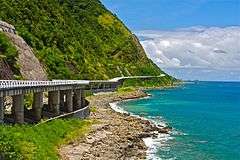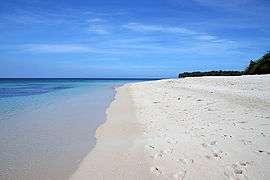Pagudpud
| Pagudpud | ||
|---|---|---|
| Municipality | ||
| Municipality of Pagudpud | ||
 From top to bottom right: Welcome arch passing through Pan-Philippine Highway, Dos Hermanos islands, Bantay Abot cave, Patapat Viaduct overlooking Pasaleng Bay, and Blue Lagoon | ||
| ||
 Map of Ilocos Norte with Pagudpud highlighted | ||
.svg.png) Pagudpud Location within the Philippines | ||
| Coordinates: 18°33′30″N 120°47′05″E / 18.55833°N 120.78472°ECoordinates: 18°33′30″N 120°47′05″E / 18.55833°N 120.78472°E | ||
| Country |
| |
| Region | Ilocos Region (Region I) | |
| Province | Ilocos Norte | |
| District | 1st District | |
| Founded | July 5, 1954 | |
| Barangays | 16 (see Barangays) | |
| Government [1] | ||
| • Type | Sangguniang Bayan | |
| • Mayor | Marlon Ferdinand Torres Sales | |
| • Electorate | 14,891 voters (2016) | |
| Area [2] | ||
| • Total | 194.90 km2 (75.25 sq mi) | |
| Population (2015 census)[3] | ||
| • Total | 23,770 | |
| • Density | 120/km2 (320/sq mi) | |
| Time zone | UTC+8 (PST) | |
| ZIP code | 2919 | |
| PSGC | 012815000 | |
| IDD : area code | +63 (0)77 | |
| Climate type | Tropical monsoon climate | |
| Income class | 4th municipal income class | |
| Revenue (₱) | 135,416,657.97 (2016) | |
| Native languages |
Ilocano Tagalog | |
| Website |
www | |
Pagudpud, officially the Municipality of Pagudpud, is a 4th class municipality in the province of Ilocos Norte, Philippines. According to the 2015 census, it has a population of 23,770 people.[3]
It is the northernmost settlement on Luzon Island and a popular tourist destination because of its resorts and beaches.
Pagudpud was made a municipality on July 5, 1954. It had previously been a part of the neighboring town of Bangui.
Geography
Pagudpud lies 74 kilometres (46 mi) north of Laoag City, the provincial capital, and 561 kilometres (349 mi) north of Manila. The town rolls over mountains, hills, valleys and flat coastal land. They reside in 5,290 homes that are spread across 83 square miles (210 km2). Most make their living through farming, fishing and subsistence retailing. Tourism is a growing part of the economy. Recently, many windmills erected in Barangay Caparispisan. Maira-ira Beach is the northernmost tip of Luzon Main Island located 18°39′4.44″N 120°50′46.68″E.
Barangays
Pagudpud is politically divided in 16 barangays:
Urban
| Names of Barangay | Brgy.No. |
|---|---|
| Poblacion 1 | 1 |
| Poblacion 2 | 2 |
Rural
| Names of Barangay | Brgy.No. |
|---|---|
| Saud | 12 |
| Caparispisan | 16 |
| Subec | 6 |
| Aggasi | |
| Saguigui | |
| Baduang | 7 |
| Burayoc | 3 |
| Dampig | |
| Tarrag | |
| Ligaya | 14 |
| Caunayan | 5 |
| Balaoi | |
| Pancian | |
| Pasaleng | 4 |
Climate
| Climate data for Pagudpud, Ilocos Norte | |||||||||||||
|---|---|---|---|---|---|---|---|---|---|---|---|---|---|
| Month | Jan | Feb | Mar | Apr | May | Jun | Jul | Aug | Sep | Oct | Nov | Dec | Year |
| Average high °C (°F) | 31 (88) |
32 (90) |
33 (91) |
34 (93) |
34 (93) |
34 (93) |
33 (91) |
32 (90) |
32 (90) |
33 (91) |
32 (90) |
31 (88) |
33 (91) |
| Average low °C (°F) | 19 (66) |
20 (68) |
21 (70) |
23 (73) |
24 (75) |
24 (75) |
24 (75) |
24 (75) |
24 (75) |
23 (73) |
22 (72) |
21 (70) |
22 (72) |
| Average rainfall mm (inches) | 6.2 (0.244) |
11.7 (0.461) |
10.1 (0.398) |
14 (0.55) |
192.7 (7.587) |
258.9 (10.193) |
470.9 (18.539) |
475.9 (18.736) |
405.7 (15.972) |
92.5 (3.642) |
44.8 (1.764) |
2 (0.08) |
1,985.4 (78.166) |
| Average rainy days | 3 | 2 | 2 | 2 | 12 | 15 | 20 | 20 | 17 | 10 | 6 | 3 | 112 |
| Source: World Weather Online[4] | |||||||||||||
Demographics
| Population census of Pagudpud | ||
|---|---|---|
| Year | Pop. | ±% p.a. |
| 1960 | 8,702 | — |
| 1970 | 11,283 | +2.63% |
| 1975 | 12,388 | +1.89% |
| 1980 | 13,675 | +2.00% |
| 1990 | 16,558 | +1.93% |
| 1995 | 17,168 | +0.68% |
| 2000 | 19,315 | +2.56% |
| 2007 | 20,385 | +0.75% |
| 2010 | 21,877 | +2.60% |
| 2015 | 23,770 | +1.59% |
| Source: Philippine Statistics Authority[3][5][6][7] | ||
In the 2015 census, the population of Pagudpud was 23,770 people,[3] with a density of 120 inhabitants per square kilometre or 310 inhabitants per square mile.
Religion
Catholic is the major religion in Pagudpud. Yet, there's also increasing numbers of members of other Christian Denomination just like Jehovah's Witnesses, having two congregations in Pagudpud and there's also Iglesia ni Cristo. Islam, brought by Muslim immigrants, is also practiced in Pagudpud.
Local government
As of the term 2013-2016, these are the officials of Pagudpud:[8]
- Mayor: Marlon T. Sales
- Vice Mayor: Rex C. Benemerito
- Councilors:
- Ferdinand R. Garvida
- Efren B. Cimatu
- Emilen G. Sales
- Rafael Ralph L. Benemerito II
- Shella L. Calvan
- Joseph P. Caliw-Caliw
- Arthur V. Malapit
- Pastor A. Aringay
Government seal

Blue, Red, Yellow, and White, reflection of the colors of the Philippines 1954, the year Pagudpud was founded
Coconut Tree and Ricefield, represents as farming as one of the economic resources of the town, with coconut, palay and vegetables as its major products
Waterfall, represents Mabogobog falls, which is the source of a Mini Hydro Power Plant.
Mountain, Tree and Logs, represents the forestry resources of the town
Fish and Shrimps, represents its marine resoureces
Shell with Pearl, symbolizes the tourism potential of the town which is famous for its white beaches
North Star, stands for the location of the town of Pagudpud, which is in the northern tip of the Province.
Transportation
By land, Pagudpud is approximately a 90-minute bus ride from Laoag City. Several bus lines serve the Manila-Laoag route, namely Partas, Florida, Farinas, and Maria de Leon among others. Some bus lines serve also the Pan-Philippine highway, the Asian Highway ends here for Taiwan the 27th Nation, dropping by in Pagudpud, namely Chona Patrick, GMW, St. Joseph, Gabriel, and the Pan-Philippine highway route buses of Maria de Leon and Florida.
Gallery
 Kabigan Falls in Pagudpud
Kabigan Falls in Pagudpud- Sunset at Burayoc Point at the juncture of Saud Beach near Pagudpud Rinnovati.
 Saud Beach near Polaris Beach House
Saud Beach near Polaris Beach House- Saud Beach near Apo Idon resort. The Northwind Power windmills in neighboring Bangui can be seen in the distance.
 The Patapat Viaduct
The Patapat Viaduct Saud Beach
Saud Beach
See also
References
- ↑ "Municipality". Quezon City, Philippines: Department of the Interior and Local Government. Retrieved 31 May 2013.
- ↑ "Province: Ilocos Norte". PSGC Interactive. Quezon City, Philippines: Philippine Statistics Authority. Retrieved 12 November 2016.
- 1 2 3 4 Census of Population (2015). "Region I (Ilocos Region)". Total Population by Province, City, Municipality and Barangay. PSA. Retrieved 20 June 2016.
- ↑ "Pagudpud, Philippines: Average Temperatures and Rainfall". World Weather Online. Retrieved 15 September 2014.
- ↑ Census of Population and Housing (2010). "Region I (Ilocos Region)". Total Population by Province, City, Municipality and Barangay. NSO. Retrieved 29 June 2016.
- ↑ Censuses of Population (1903–2007). "Region I (Ilocos Region)". Table 1. Population Enumerated in Various Censuses by Province/Highly Urbanized City: 1903 to 2007. NSO.
- ↑ "Province of Ilocos Norte". Municipality Population Data. Local Water Utilities Administration Research Division. Retrieved 17 December 2016.
- ↑ "Official City/Municipal 2013 Election Results". Intramuros, Manila, Philippines: Commission on Elections (COMELEC). 11 September 2013. Retrieved 3 October 2013.
External links
| Wikimedia Commons has media related to Pagudpud. |
| Wikivoyage has a travel guide for Pagudpud. |